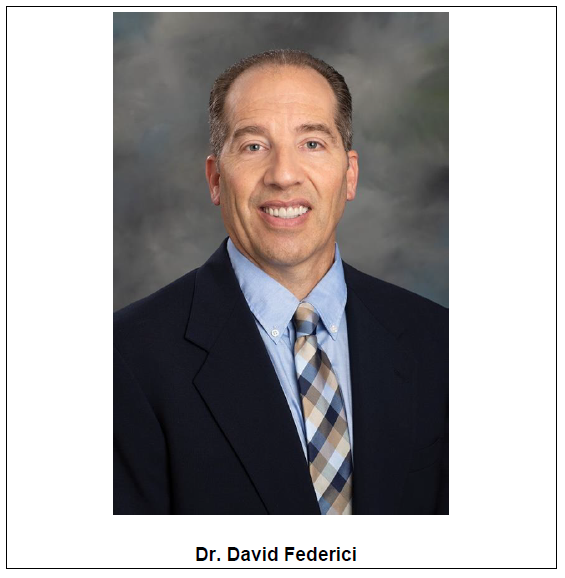
Special Article 1, Issue 9.2
How I Landed a Position on My State’s Sleep Society Board: JDSM Interview with Dr. David Federici
Disclaimer: The use, mention or depiction of any product, device, service or appliance shall not be interpreted as an endorsement, recommendation or preference by the AADSM. Any opinion expressed is solely the opinion of the individual, and not that of the AADSM.

Recently, the Journal of Dental Sleep Medicine editorial staff spoke with Dr. David Federici, DMD, D.ABDSM, a New Jersey-based dentist and member of the AADSM. We asked him to tell us about his experience with building referrals through his state sleep society. He wrote to us:
“A few years ago, when I completed the AADSM’s Mastery program to take my sleep game up to the highest level (Diplomate), I decided I had to promote my new designation. I wanted to take my referral networking up a notch as well, so I researched my state’s sleep society. I decided to attend one of their weekend sleep symposia. I had reviewed their website/sponsors section and saw that there were no dental office sponsors, and I asked if my practice could become one. They said they did not have any, only medical and labs - “but you are now the first member dental center sponsor.” They had also mentioned I could stay for the board meeting at the end of the symposium, as it was open to all.
During the first day’s lunch break, I was fortunate enough to sit at a table with two sleep physicians, one pulmonologist, one neurologist, and two sleep lab techs. For an hour, I was able to become a source of learning for them about dental sleep medicine. With my Diplomate status and all that comes with it, the hour became not quite an interview, but more a Q&A for them. My ability to speak with them out of the office environment and explain what we do from screening to fabrication of DME was very enlightening to them. We discussed topics ranging from dentists being the doctors of the oral cavity, how the tissues we screen for oral cancer are the same ones that can predispose a patient for OSA to appliances, to pulse oximetry and digital scanning technology. Most at the table were totally unaware of all the aspects of what and how we treat with oral appliance therapy. Most thought Mastery was a weekend course - you take impressions, move the jaw arbitrarily forward and hope we succeed without TMJ issues. Most expressed a newfound admiration/appreciation of what a Diplomate does for the referred patient.
Later, I attended the board meeting and had noticed that one of the doctors who had been sitting at the table at lunch was present. I did offer several comments during the open forum and it became apparent that what I was saying was being well received. In fact, they asked if I would be interested in joining the board. I said, “absolutely.” They then asked me to kindly leave the room for a vote, and upon returning they said, “congratulations and welcome to the NJ Sleep Society board.”
So, as you become more confident in your education and comfortable speaking to physicians, seek out opportunities. Assume every conversation you have with a stranger may influence or lead to a possible pathway to bettering the treatment of OSA by dentists. It is only through continued collaborative efforts by all that we achieve the best possible treatment of OSA.
We also asked Dr. Federici some additional follow-up questions on his experience with the New Jersey Sleep Society. These were his responses:
CAN YOU TELL US MORE ABOUT YOUR EXPERIENCE SERVING ON THE NJ STATE SLEEP SOCIETY BOARD?
“The board meets once a year to discuss upcoming speakers/agenda for the following year's Sleep Symposium.We try to diversify the speakers and topics to include various angles on sleep, from pediatric to narcolepsy and now to more dental!It has been a bit frustrating to not have more dentists attend.I am hopeful more will attend in the future. A lot of networking transpires during breaks and at lunches, which is where I got my “in” to speak to what Diplomates do for treatment.”WHAT OTHER ADVICE DO YOU HAVE FOR DENTISTS WHO WANT TO DO MORE TO NETWORK WITH PHYSICIANS?
“I started networking with primary care physicians, who still to this day only get 2 hours on OSA in their 2nd year of medical school. I gave them some general information about OSA and what we as trained dentists can do to treat it.I gave them our full screening workflow including questionnaires, oral cavity assessment including Mallampati, and co-morbidities patients may currently have for OSA.I recommend that you preface the conversation by asking the physician what they do to screen and whether they refer via HSAT themselves or refer to sleep physicians/pulmonologists?Most usually say "not what you are doing that's for sure!" Then, give them workflow paperwork based on their treatment or routes of referral.I always give them document referral sheets that have various request options for both HAST, SOAP notes, as well as how I need their prescription written out for OAT.I also differentiate Medicare vs private insurance, all the while enlightening them that both pay for oral appliances, which most don't realize.”
